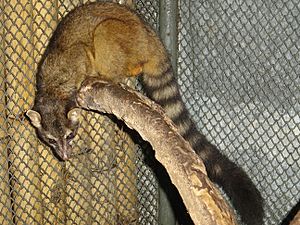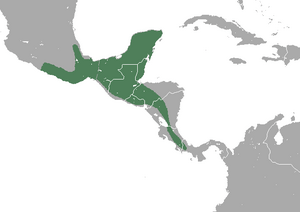Cacomistle facts for kids
Quick facts for kids Cacomistle |
|
|---|---|
 |
|
| Conservation status | |
| Scientific classification | |
| Genus: |
Bassariscus
|
| Species: |
sumichrasti
|
 |
|
| Cacomistle range | |
The cacomistle (pronounced kah-koh-MIST-lee) is a fascinating animal. It is a type of carnivoran, part of the same family as raccoons and coatis. These creatures are mostly active at night, which means they are nocturnal. They also spend most of their lives in trees, making them arboreal. Cacomistles are omnivorous, meaning they eat both plants and animals.
You can find cacomistles in wet, tropical forests. They especially like evergreen woodlands and mountain forests. Sometimes, they might visit drier deciduous forests too. Their home stretches from southern Mexico all the way to western Panama. However, they are not very common anywhere in this large area. In Costa Rica, for example, they live in only a tiny region. Because they rely so much on forests, losing these habitats due to deforestation is a big problem for them.
The name cacomistle comes from the Nahuatl language. It means "half cat" or "half mountain lion." Sometimes, people also use this name for the Ring-tailed cat, which looks similar. The ring-tailed cat lives in drier areas like northern Mexico and the Southwestern United States.
Contents
What is a Cacomistle?
Cacomistles belong to the animal family called Procyonidae. This family includes other small animals that eat many different things, like raccoons and coatis. The cacomistle and its close relative, the Ring-tailed cat, are the only two living species in their specific group, called Bassariscus.
There are actually five different types, or subspecies, of cacomistles. These include Bassariscus sumichrasti variabilis, Bassariscus sumichrasti sumichrasti, Bassariscus sumichrasti oaxacensis, Bassariscus sumichrasti notinus, and Bassariscus sumichrasti latrans.
How Does a Cacomistle Look?
A cacomistle's body is usually about 38 to 47 centimeters (15 to 18.5 inches) long. Its tail is often just as long, or even longer, typically measuring 39 to 53 centimeters (15 to 21 inches). Male cacomistles are usually a bit longer than females. However, both males and females weigh about the same, usually between 1 and 1.5 kilograms (2.2 to 3.3 pounds).
Their fur is a mix of dark brown and grey. This contrasts sharply with their black and white striped tail. The stripes are clearest near the body and slowly fade to solid black at the tail's tip. Cacomistles are often confused with the Ring-tailed cat because they look alike. But unlike ring-tailed cats, cacomistles cannot pull their claws back in. You can also tell a cacomistle by its faded tail stripes and its pointy ears.
Where Do Cacomistles Live?
Cacomistles live in the tropical forests of North America and Central America. Their range extends from south-central Mexico down to Panama. These animals prefer to live alone. Each cacomistle usually has its own home range of at least 20 hectares. That's an area as big as 20 sports fields! They are often seen high up in the middle and upper parts of the forest trees.
Even though they live across a wide area, cacomistles can be found in many different forest types. In Mexico, they tend to stay away from oak forests and areas where forests have grown back after being cut down. But in Costa Rica, cacomistles actually seem to prefer those exact places!
What Do Cacomistles Eat?
Cacomistles are known as "generalist feeders." This means they can eat many different kinds of food to survive. Their diet mostly includes fruits, insects, and small vertebrates. These small animals can be reptiles, amphibians, and rodents. What they eat specifically depends on what is available in their habitat.
For example, in the southern parts of their range, bromeliad plants are a great source of food. These plants naturally collect water, insects, and small animals high up in the trees.
How Do Cacomistles Have Babies?
Cacomistles usually only meet each other during mating season. The female is only ready to mate for one day. After mating, the female cacomistle is pregnant for about two months. She then gives birth to a single baby, called a cub.
When the cub is three months old, it stops drinking its mother's milk. After that, its mother teaches it how to hunt and survive on its own. Once it learns these important skills, the young cacomistle leaves to find and create its own territory.
See also
 In Spanish: Cacomixtle tropical para niños
In Spanish: Cacomixtle tropical para niños



